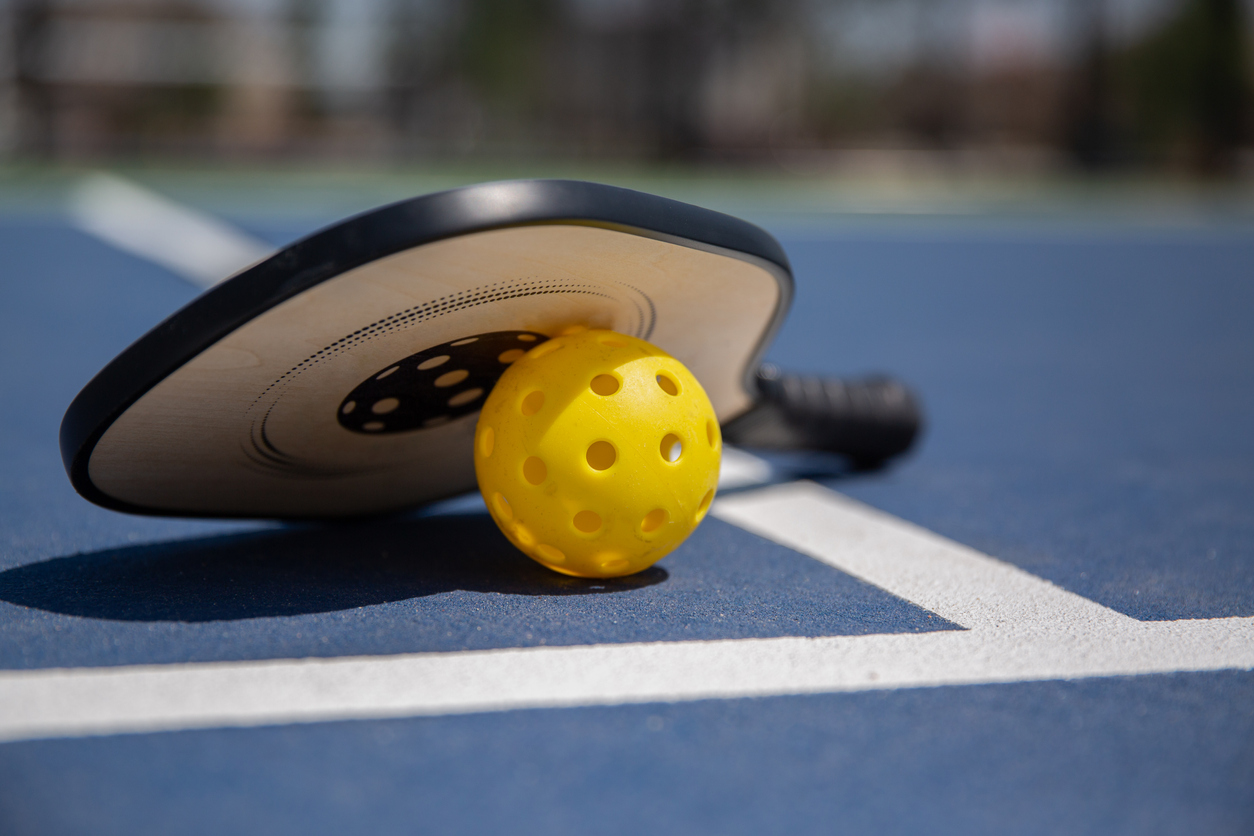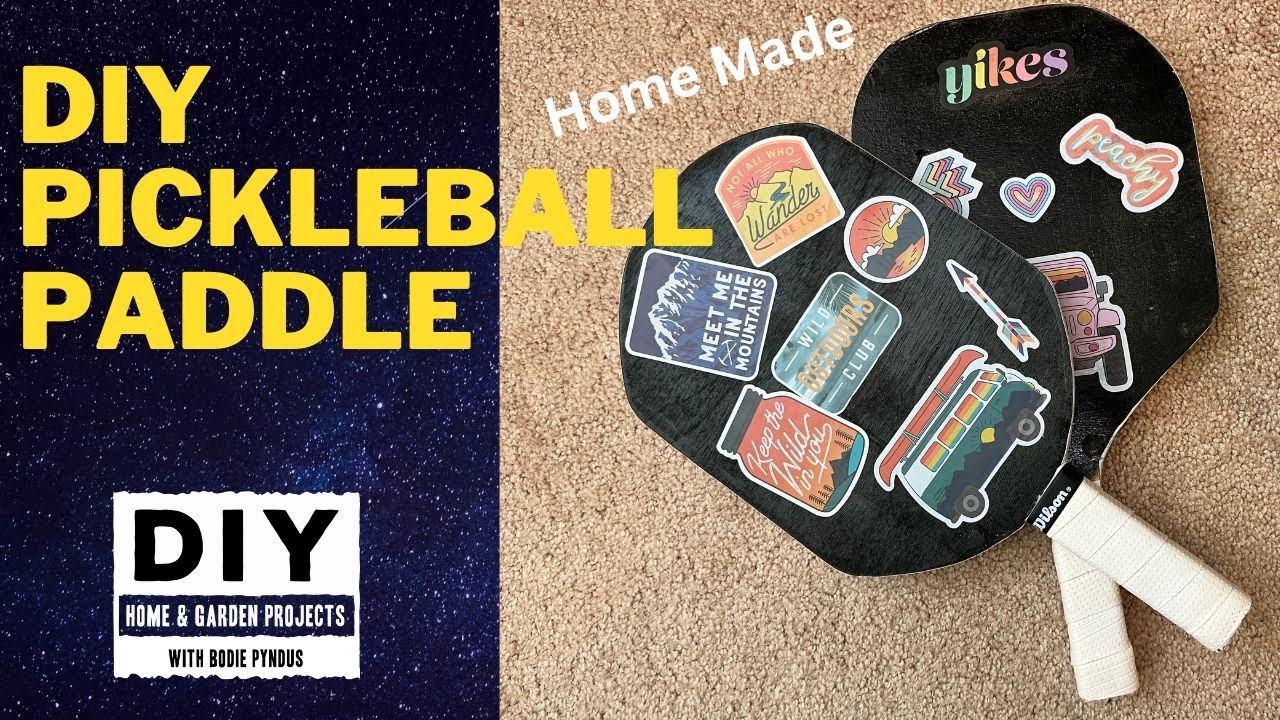To make a pickleball paddle, gather materials such as wood, a pencil, a ruler, and a pair of scissors. Measure and mark the dimensions on a piece of cardboard.
Use the cardboard as a template to cut out the shape of the paddle. Sand the edges for a smooth finish. Apply a sealant or paint to protect the wood. Finally, attach a grip or handle to the paddle.

Credit: www.austinfitmagazine.com
Materials Needed For Diy Pickleball Paddle Craft
htmlIf you’re looking to make your own pickleball paddle, there are a few key materials you’ll need to gather. Each component plays a crucial role in the construction process, ensuring the final product is durable and high-performing. In this section, we’ll cover the essential materials needed to craft your very own pickleball paddle. From wood to carbon fiber, epoxy resin to grip tape, these elements come together to create a paddle that’s perfect for your game. Let’s dive in and explore the materials needed for this DIY project.
Wood
One of the most common materials used in homemade pickleball paddles is wood. Wood provides a solid and sturdy base for your paddle, offering stability and control during gameplay. You’ll need a high-quality piece of wood that is strong enough to withstand the impact of the ball. Choose a dense and durable wood, such as hardwood or plywood, for the best results. Be sure to measure and cut the wood to the appropriate size for your paddle dimensions.
Carbon Fiber
For those looking to create a lighter and more maneuverable pickleball paddle, carbon fiber is an excellent choice. Carbon fiber provides strength and flex, allowing for quick and precise shots on the court. This material is known for its lightweight properties and durability, making it a popular option among serious pickleball players. Incorporating carbon fiber into your paddle design can enhance your performance and control on the court.
Epoxy Resin
To ensure the longevity and durability of your pickleball paddle, epoxy resin is an essential component. Epoxy resin acts as a protective coating, sealing the paddle’s surface and providing resistance against wear and tear. It also adds strength and stability to the paddle, allowing it to withstand the demands of intense gameplay. Applying epoxy resin to your paddle will help preserve its quality and performance over time.
Grip Tape
A comfortable and secure grip is crucial for optimal performance on the pickleball court. Adding grip tape to your paddle handle allows you to maintain a firm hold, preventing slips and enhancing control. Choose a high-quality grip tape that offers both durability and comfort. The right grip tape can make a significant difference in your gameplay by minimizing hand fatigue and maximizing your maneuverability.
Paint
Adding a personal touch to your pickleball paddle is easy with a coat of paint. Not only does paint allow you to customize the appearance of your paddle, but it also adds a layer of protection against scratches and damage. Choose a paint color or design that reflects your style and personality. Just be sure to use paint that is suitable for the paddle material to ensure long-lasting results.
Varnish
To further protect your pickleball paddle from the elements and enhance its longevity, applying a coat of varnish is recommended. Varnish provides a clear protective layer that shields the paddle from moisture, scratches, and UV rays. It also adds a smooth finish to the paddle surface, improving grip and overall playability. Select a high-quality varnish that is suitable for the type of wood or material used in your paddle construction.
Steps To Create Your Own Pickleball Paddle
In this section, we will walk you through the step-by-step process of creating your own pickleball paddle. Making your own paddle allows you to personalize and customize it according to your preferences and playing style. With these simple steps, you’ll be able to craft a unique and high-quality pickleball paddle that you can be proud of.
Step 1: Choosing The Right Material
The first step in creating your own pickleball paddle is to choose the right material. You have several options to consider, including wood, carbon fiber, and composite materials. Each material offers different levels of durability, control, and power. Consider your playing style and skill level when selecting the material for your paddle.
Step 2: Purchasing The Materials
Once you have decided on the material, it’s time to purchase the necessary materials. Make a list of the specific items you need, such as the chosen paddle material, adhesive, paint, sandpaper, and varnish. You may also need tools like a bandsaw, sanding block, and brushes. Visit your local hardware or sporting goods store to gather all the materials required for the construction.
Step 3: Drawing The Paddle Outline
With the materials gathered, the next step is to draw the outline of the paddle on your chosen material. Measure and mark the dimensions of a standard pickleball paddle on the surface of the material. Use a pencil or marker to ensure accuracy and precision in your outline.
Step 4: Cutting Squares For The Paddle
After drawing the paddle outline, you’ll need to cut squares from the material. Carefully use a saw or a cutting tool to create the square shape. Make sure to follow the outline you previously drew to maintain the desired dimensions and shape of the paddle.
Step 5: Bandsaw Shape Cutting
Following the cutting of squares, you’ll need to shape the paddle using a bandsaw. The bandsaw allows for more precise and controlled shaping. Gently guide the material through the bandsaw, slowly cutting away excess material to form the desired shape of the paddle.
Step 6: Sanding The Paddle
After shaping the paddle, it’s time to smooth the surface using sandpaper. Start with a coarse grit sandpaper and gradually move to finer grits. Sanding helps remove rough edges and imperfections, ensuring a smooth and even surface.
Step 7: Reshaping Through Sanding
If you need to refine the shape of the paddle or make any adjustments, you can use sandpaper to reshape certain areas. Be careful not to remove too much material, as this can affect the overall performance of the paddle.
Step 8: Hand Sanding For Finer Finish
For a finer finish, you can hand sand the paddle with a very fine grit sandpaper or sanding sponge. This process helps achieve a smooth and polished surface, ready for painting or varnishing.
Step 9: Painting The Paddle
Now comes the fun part – painting the paddle. Choose a paint color that resonates with your personality or matches your playing style. Apply multiple coats of paint, allowing each coat to dry before applying the next. Ensure the paint is even and smooth across the entire surface of the paddle.
Step 10: Cleanup And Varnish Application
After the paint has dried, it’s important to clean up any excess paint or debris from the paddle. Use a cloth or brush to remove any particles. Once clean, you can apply a coat of varnish to protect the paddle and give it a professional finish. Allow the varnish to dry completely before moving on to the next step.
Step 11: Wrapping Handles For Grip
For a comfortable grip, wrap the handle of the paddle using grip tape. Start at the bottom of the handle and slowly wrap it upward in a tight and secure manner. Make sure the grip tape is smooth and provides enough cushion for a comfortable and secure hold.
Step 12: Testing The Paddle
Before taking your newly crafted paddle out on the court, it’s essential to test it to ensure it meets your expectations. Practice hitting shots to assess the paddle’s performance in terms of power, control, and feel. Make any necessary adjustments if needed.
Step 13: Playing Pickleball With Your Diy Paddle
Finally, it’s time to put your DIY pickleball paddle to the test by playing a game. Enjoy the fruits of your labor and see how your personalized paddle enhances your gameplay. Embrace the satisfaction of knowing you created a functional and unique pickleball paddle from scratch.
Tips And Considerations For Crafting Your Own Pickleball Paddle
htmlCreating your own pickleball paddle can be a rewarding and personal experience. By crafting your own paddle, you have the freedom to choose the materials, customize the appearance, and tailor the paddle to your specific preferences. Whether you’re a seasoned craftsman or a beginner woodworker, these tips and considerations will guide you through the process of making your own pickleball paddle.
When it comes to crafting your own pickleball paddle, selecting the right wood type is crucial for the paddle’s performance and durability. Some popular wood types used for pickleball paddles include:
| Wood Type | Properties |
|---|---|
| Maple | Hard and dense wood for excellent power and control |
| Birch | Durable and lightweight wood for a balanced paddle |
| Poplar | Softwood with a good feel and responsiveness |
When choosing plywood for your pickleball paddle, make sure to select a high-quality, void-free plywood. Plywood with voids can weaken the paddle and affect its overall performance. It’s recommended to use a 5-ply or 7-ply plywood for optimal strength and stability.
The weight and balance of your pickleball paddle can significantly impact your gameplay. Consider the following:
- Weight: A heavier paddle provides more power and stability, while a lighter paddle offers better maneuverability.
- Balance: Paddle balance refers to the distribution of weight between the handle and the face. A balanced paddle offers a combination of power and control.
To enhance the durability of your pickleball paddle, apply a layer of epoxy resin to the face and edges. Epoxy resin creates a protective barrier against wear and tear, prolonging the lifespan of your paddle.
Choosing the right grip tape is essential for a comfortable and secure grip. Look for grip tape that provides good cushioning and is sweat-resistant for a better playing experience. Consider using overgrip tape for easy replacement and customization.
Painting your pickleball paddle allows you to personalize its appearance. Follow these painting techniques for a professional finish:
- Prime the paddle face with a suitable primer to ensure paint adhesion.
- Apply thin and even coats of paint, allowing each coat to dry before applying the next.
- Use stencils or masking tape to create designs or patterns.
- Finish with a clear coat to protect the paint and provide a glossy look.
After painting your pickleball paddle, consider applying a varnish coat to further protect the paint and provide a glossy finish. Varnish adds an extra layer of durability and enhances the aesthetic appeal of your paddle.
Customizing the appearance of your pickleball paddle allows you to stand out on the court. Here are a few ways to make your paddle unique:
- Use different paint colors and patterns.
- Apply decals or stickers.
- Engrave your initials or a design on the handle.
While crafting your own pickleball paddle, it’s important to avoid these common mistakes:
- Using low-quality or unsuitable materials.
- Skipping the proper sanding and finishing process.
- Using too much epoxy resin, resulting in a heavy paddle.
- Not ensuring proper weight and balance distribution.
Frequently Asked Questions For How To Make A Pickleball Paddle
Can You Make Your Own Pickleball Paddles?
Yes, you can make your own pickleball paddles by following DIY instructions and using materials like wood or carbon fiber.
How Do You Make A Pickleball Paddle Cover?
To make a pickleball paddle cover, gather materials such as fabric, sewing machine, thread, and closures. Measure the paddle dimensions, add seam allowance, and cut the fabric accordingly. Sew the fabric pieces together, leaving an opening to insert the paddle.
Attach closures to secure the cover.
How Do You Size A Pickleball Paddle?
To size a pickleball paddle, follow these steps: 1. Hold the paddle in your hand and check that your fingertips reach the edge of the paddle face. 2. Ensure that you can comfortably wrap your fingers around the grip. 3.
The paddle should feel balanced and not too heavy or too light. 4. It’s recommended to try different sizes and weights to find the one that feels right for you. 5. Consider consulting a pickleball expert or trying out different paddles at a sports store to ensure the best fit.
How Do You Pick The Weight Of A Pickleball Paddle?
To pick the weight of a pickleball paddle, consider your playing style and preferences. Heavier paddles provide more power, while lighter ones offer greater control. Test different weights to find what works best for you.
Conclusion
Crafting your own pickleball paddle can be a rewarding and cost-effective venture. By following the step-by-step instructions provided in this blog post, you can create a custom paddle that suits your playing style. From selecting the ideal materials to shaping and painting the paddle, every aspect is covered in detail.
So, why wait? Embrace your DIY spirit and embark on this exciting journey to create a pickleball paddle that is uniquely yours. Start playing your favorite game with a paddle you made with love!

